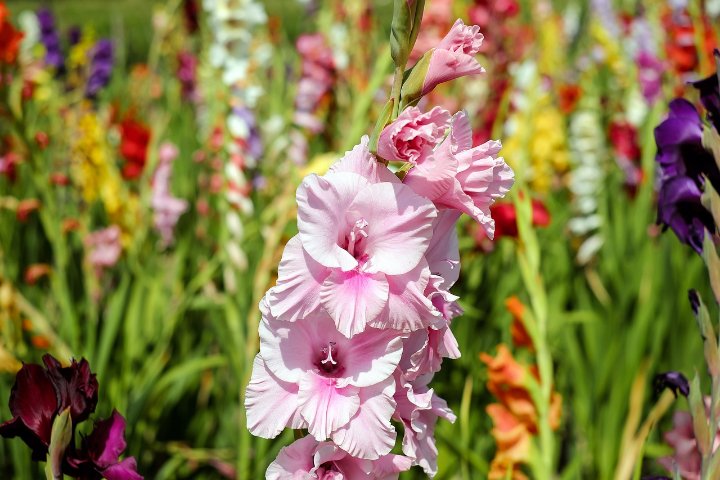Gladiolus, also known as sword lilies, are beautiful flowering plants that can add a touch of elegance to any garden or landscape. These vibrant and showy flowers are relatively easy to grow, making them a popular choice among gardeners.
Best Gladiolus Varieties
| Image | Name | Rating | Shop |
|---|---|---|---|
 | Mixed Gladiolus Flower Bulbs – 50 Bulbs Assorted Colors |  | |
 | Gladiolus, Border Growing Mix |  | |
 | Purple Gladiolus |  |
How to Grow and Care for Gladiolus
Gladiolus Care
Gladiolus, scientifically known as Gladiolus palustris but commonly referred to as Gladiolus, is a stunning flowering plant that adds vibrant colors to any garden. This perennial beauty thrives in USDA hardiness zones 7-10 and grows from corms. Gladiolus can reach a mature size of 2-5 feet, making it a striking addition to both gardens and floral arrangements.
Light
Gladiolus plants thrive in full sun, requiring at least five hours of direct sunlight each day to flourish. Plant them in a location where they can bask in the sun’s warmth and receive ample natural light.
Soil
When it comes to soil, Gladiolus prefers a well-draining sandy loam. Aim for a soil pH between 6.0 and 6.5 to provide optimal growing conditions for these magnificent flowers. Proper soil preparation ensures healthy root development and robust growth.
Water
Proper watering is essential for the health and vitality of Gladiolus plants. Water them weekly, ensuring that the soil remains consistently moist but not waterlogged. Avoid overwatering, as it can lead to root rot and other moisture-related issues.
Temperature and Humidity
Gladiolus thrives in moderate temperatures, preferring daytime temperatures above 70 degrees Fahrenheit and nighttime temperatures around 60 degrees Fahrenheit. Maintain adequate humidity levels to prevent stress and promote healthy growth.
Fertilizer
To support healthy growth and abundant blooms, feed Gladiolus plants with a balanced 10-10-10 liquid fertilizer during the growing season. Apply fertilizer according to package instructions, taking care not to over-fertilize, which can cause damage to the plants.
How to Grow Gladiolus From Corms
To grow Gladiolus from corms, start by selecting healthy, firm corms measuring around three inches in diameter. Plant them in well-prepared soil, spacing them six to eight inches apart and planting them three to four inches deep. Water thoroughly after planting, and continue to water regularly throughout the growing season.
Pest and Disease Problems with Gladiolus
While Gladiolus plants are relatively resilient, they can be susceptible to pest infestations and disease issues. One common issue that gardeners may encounter when growing gladiolus is thrips. These tiny insects can damage the flowers and leaves by piercing them and sucking out the sap, resulting in distorted or discolored foliage. To control thrips, you can apply insecticidal soap or neem oil according to the product instructions. Additionally, maintaining good garden hygiene, removing weeds, and regularly inspecting your plants for signs of pests can help prevent infestations.
Pruning
Pruning is an essential part of gladiolus care. Once the flowers fade and die, it’s important to remove them promptly to prevent seed formation. This redirects the plant’s energy towards bulb development and future flower production. Cut the spent flower stalks back to the base of the plant using clean and sharp pruning shears. Additionally, remove any yellow or damaged leaves to maintain the plant’s overall health and appearance.
Types of Gladiolus
There are numerous cultivars of Gladiolus, each offering its unique colors, sizes, and bloom patterns. Some popular varieties include ‘Atom,’ known for its vibrant red blooms; ‘Robinetta,’ featuring delicate pink flowers; and ‘Rose Supreme,’ prized for its elegant rose-colored petals.
Here are a few popular varieties to consider:
– Atom: This variety features red flowers with a white border, creating a striking contrast.
– Boone: Known for its yellow blooms, this variety is hardy and suitable for Zone 6 and similar climates.
– Green Lace: With ruffled blooms, this gladiolus cultivar adds a touch of elegance to any garden.
– Lucky Star: This variety not only produces stunning white and red flowers but also boasts a strong fragrance, adding a delightful scent to your garden.












